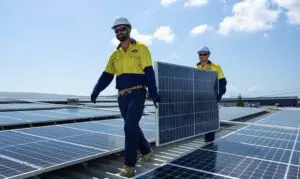 A leading energy researcher has taken aim at Australia’s opaque National Electricity Market, arguing that its lack of transparency and competition is being exacerbated by current federal government policy, and could get worse under the proposed National Energy Guarantee.
A leading energy researcher has taken aim at Australia’s opaque National Electricity Market, arguing that its lack of transparency and competition is being exacerbated by current federal government policy, and could get worse under the proposed National Energy Guarantee.
Dr Iain MacGill, who is an associate professor at UNSW and joint director for its Centre for Energy and Environmental Markets, says the Renewable Energy Target has helped deliver reduced solar and wind costs, mostly via reverse auction schemes, and led by the ACT.
But in an address at the APVI Asia Pacific Solar Research conference in Melbourne on Thursday, MacGill argued that in the context of Australia’s “broken” energy market, even this renewables success story has a down side – inadvertently delivering more power to the big three gen-tailers who already dominate the market: AGL, Origin and EnergyAustralia.
“(It) puts the power into the hands of large incumbents, who will actually use tenders to get their own costs down, but they won’t necessarily pass on the savings to you,” MacGill said.
And he pointed to the example of Origin Energy’s PPA for Stockyard Hill wind farm, which – as we reported here in May – stunned the industry at the time, with a record low price for electricity of somewhere between $50 and $60/MWh.
“We don’t even know what the price is,” MacGill said, echoing concerns detailed by Giles Parkinson earlier this week, in which he noted that the last official (PPA) price we heard of was $A180/MWh in 2013, since which time we’ve relied on speculation.
“The question is what’s Origin going to charge you for that energy and that renewable energy certificate? …If they can get away with it, it’s $120 for the black and it’s $80 for the REC. And they’re paying $50 to $60. That’s complicated!”
It certainly is. And the even greater concern is that it’s a good chance to get worse, under the federal government’s proposed National Energy Guarantee.
“Ten years ago, five years ago, I pretty much would have agreed that the RET approach captured integration in an important way,” MacGill told the conference.
“The RET uses a certificate based approach, and …it certainly exposes renewable energy developers and operators to energy market signals,” he said.
“Unfortunately, what is this market that we’re saying we want projects bering exposed to?
“Well, it’s a market with pretty significant increases in wholesale costs, very high retail costs for residential; pretty high renewable costs as well.
“So what our market appears to have delivered right now… is amongst the world’s most expensive wholesale, retail and renewable energy electricity. It’s reliable but it’s also one of the dirtiest industries in the world as well. Great outcome, huh?”
MacGill says that the large-end users are getting wise to this pattern, and are developing their own projects using tenders, as we have seen from industry players like Liberty OneSteel and Sun Metals.
“But for the rest of us, we’re vulnerable.”
The challenge for Australia as it moves forward with renewables, says MacGill, is maximising the value they bring – and not just for a small group of market players.
“Now energy markets don’t capture key values, certainly energy markets that introduce a carbon price and then take it away – the only place in the world that’s done that so far – so there’s a policy role, but which mechanisms?”
As MacGill notes, a great deal of work has been done on answering that question. But the short answer is – not the NEG.
“We need to fix the NEM, it’s broken, and the NEG will likely make it worse,” he said, namely by reducing transparency even further.
“Lack of transparency is a real issue in markets, particularly markets with the potential exercise of market power.
“And the NEG moves both emissions challenges and reliability challenges, however they’re eventually going to be defined, over to the same retailers who are currently running the thing into the ground.
“So that’s the issue with the NEG, I think. There are other approaches we could take to both reliability and emissions reductions that would provide much higher transparency,” he continued.
“In the end, we’re going to pay for this, so we should know what we’re paying for.”







